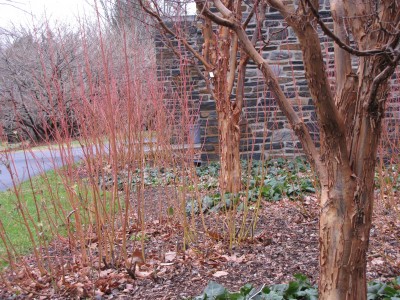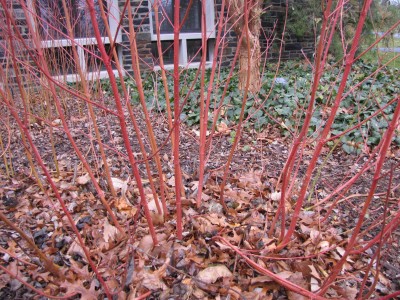While walking through campus last week on a cold, dreary day, I was pleasantly surprised to see the arboretum popping with vibrant colors and textures. In front of McCabe Library, I enjoyed the beautiful color displays of our red-berried deciduous hollies (Ilex verticillata). At the Harry Wood Garden, I delighted in the beautiful showing of delicate camellia blossoms (my favorite is Camellia oleifera ‘Winter’s Interlude’.) However, one of the most striking spots I came across during my winter stroll was in front of Sharples Dining Hall. Here, amid the richly textured bark of several paperbark maples (Acer griseum), I found a vibrant display of Cornus sericea ‘Cardinal’, the red osier dogwood, this month’s pick for Plant of the Month.
The red osier dogwood is certainly at its best this time of year. Arguably the most noteworthy feature of this multi-stemmed, deciduous plant is its brightly colored red twigs that reveal themselves once the plant drops its leaves. Especially on overcast winter days, this plant commands attention to passersby; it is even more striking against a snowy backdrop, a scene which we will likely have the chance to see one time or more again this winter.

Harmony of color and texture with Cornus sericea 'Cardinal' and Acer griseum (paperbark maple) in front of Sharples Dining Hall. photo credit: Miriam Pinsker
Cornus sericea has a wide geographic range; however, in warmer zones its twigs may appear more yellowish. The deepest red color occurs on new shoots and, over time, old stems can lose some color. Therefore, to ensure the best possible red twig color, it is recommended to renewal prune C. sericea ‘Cardinal’. This process involves selective thinning, by removing about 50 percent of its oldest stems in early spring. A more severe way to renewal prune is to cut the entire plant back every year, but this may be a more drastic approach than some home gardeners will want to take. Also, unlike last month’s Plant of the Month, Callicarpa dichotoma ‘Issai’, which flowers and fruits on new wood, C. sericea ‘Cardinal’ flowers and fruits on old wood. So, in your decision to prune or not to prune, keep in mind that there exists a trade-off between bright twig color and heavy flowering/fruiting for the coming season. Cornus sericea ‘Cardinal’ produces flat-topped clusters of creamy-white flowers in the spring, followed by small white-bluish fruits in the summer.
Cornus sericea is native to North American wetlands and stream banks; as such, this plant is best grown in rich wet soils, but it can tolerate a range of soils in full sun to part shade. Because of its wide geographical distribution, C. sericea has accumulated many common names over the years. Most commonly referred to as the red osier or red-twig dogwood in the Northeast, some of its other pseudonyms include: redstem dogwood, American dogwood, creek dogwood, kinnikinnik, squawbush, red willow, gutter tree, harts rouges, poison dogwood, shoemack, and dogberry tree! Regardless of what you call it, Cornus sericea ‘Cardinal’ is a great addition to a winter landscape. Stop by the Scott Arboretum this month to see this plant, as well as other winter-interest plants. Happy Holidays!

